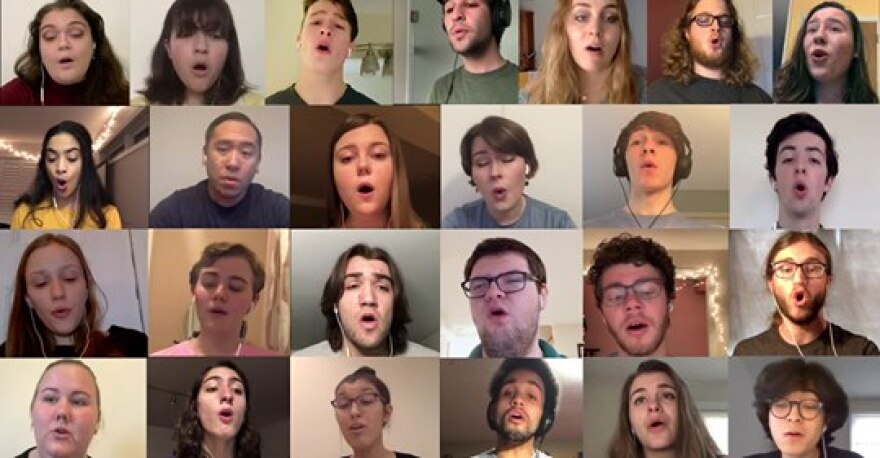As the world shifts to online communication during this pandemic, people are finding creative ways to replicate face-to-face situations in the virtual world -- think business meetings, online cocktail hours and livestreaming concerts.
But technology hasn’t quite caught up with at least one type of real-life endeavor -- choral singing.
We depend on your support. Donate to Connecticut Public today.
That may sound surprising. Take a quick look on Facebook or YouTube and you’ll find countless videos made by virtual choirs singing things like Handel’s Hallelujah Chorus or Down to the River to Pray from the movie O Brother, Where Art Thou? Typically, these videos resemble a Zoom meeting -- a “Brady Bunch” array of boxes filled with singers, perfectly blending with the other boxes in the video.
I’ll let you in on a little secret: The singers in these videos are not singing together in real time.
They record their parts separately, and the parts are then mixed together after the fact.
Recently, the UConn Chamber Singers posted a virtual performance of That Lonesome Road by James Taylor on YouTube.
Adam Giroux is a junior at UConn who sang tenor II in this video. He found recording his part for the project to be a lonely exercise.
“Choir is about making art with other people,” said Giroux. “And when you take that away it just becomes a project. It is mostly like singing into a void. OK, this is cool but kind of pointless.”
And therein lies the problem with choirs and social distancing. There is no technology on the market that comes close to replicating a real-world choral experience. So for now, choir directors must improvise, using the technology that is available.
“I have really liked using Zoom. For me, that’s just the one that I clicked with,” said Meredith Neumann, director of the Connecticut Children’s Chorus and head of choral activities at the Hartt School Community Division. “I like the sharing of the computer audio and all of that, it’s pretty easy. You are able to do more than you think you might be able to.”
Still, the Zoom rehearsal is challenging and contradicts some of the basic principles of good choral singing, like good tone and blend.
“How do you get everyone to sing together and hear each other, in sync, at the same time? Oh man, it’s just not going to happen,” said Katie Houts of the Choristers Guild, a resource for choir directors and singers. “The technology just isn’t there yet. We are at the mercy of internet connection speeds.”
So, if your singers can’t hear one another, what’s a choir director to do? Neumann has a workaround where she mutes her singers’ computer mics.
“I will sing along with them, so that it at least gives them, not the illusion, but at least they are singing with one other voice. It's not like singing alone and singing in awkward silence. But no, you are not going to hear them in a group.”
Still Neumann sees value in the Zoom choir rehearsal. An important part of that for her is letting kids be kids.
“Because we are not being social right now, I think the most important thing is letting them be social, so I give them about 10 minutes of complete free rein, no muting of anything. I let them talk, I let them do sillies, I let them get it all out.”
Then it’s time to get down to work.
Neumann said she’ll start with a YouTube video of a choir piece they are currently working on. Then she'll pick a trickier section of a piece in the repertoire and practice it. Neumann said a great feature of Zoom is that she can play the accompaniment for the piece they are working on from her computer, and her singers can hear it and sing along.
“And I can even conduct along, which is very cool. It will look delayed to me, but it won’t feel delayed to them,” said Neumann. “My conducting will line up perfectly with the recording. And they love it. They can see each other singing along, they hear the background, they see the conductor, and then that’s it. That’s a typical rehearsal.”
Giroux said for him, there are some benefits to the Zoom choir rehearsal. Without the frantic pace of learning music quickly for upcoming performances, he said the UConn Chamber Singers choir has had time to look at the repertoire in a more thoughtful way.
“Through this whole thing we’ve learned the meaning of the whole piece, which we don’t really talk about, which is important,” said Giroux. “And so I just think that we could bring back some of that when we all meet up together again and realize that when we all share our ideas and talk through things we have a better product at the end of the day.”
Until it’s safe for choirs to rehearse together in person, Zoom seems to be the app of choice for choral directors and music teachers, and now there is research to back up that choice.
According to a study last month by the New England Conservatory of Music, among the four commonly used apps for online music lessons, Zoom had the highest fidelity in terms of both range of dynamic sound and frequencies.





